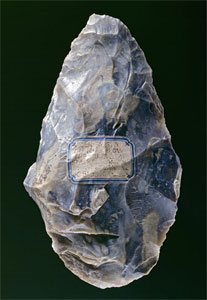Sir John Evans's collections of artefacts - France
St Acheul handaxe |
||
 Handaxe from a quarry near St Acheul, Amiens (AN1928.221g) |
This flint handaxe dates from the Lower Palaeolithic (c. 350,000-400,000 years ago). Handaxes are symmetrical bifacial (worked on both faces) stone tools used throughout much of Europe, Africa and Asia during the Lower Palaeolithic. They are presumed to be multi-purpose tools, used for a variety of tasks including butchery and woodworking. They are often referred to as of ‘Acheulian’ type, after the site where they were first recognised as being manufactured items found with the bones of extinct animals. This discovery was investigated by Sir John Evans and in 1859 formed the basis of his assertion of an extended antiquity for humans beyond the accepted biblical chronology. Evans found this handaxe in situ 10 feet 10 inches below the surface at the St Acheul quarry, Amiens (Somme) in France. It was presented to the Ashmolean by Sir Arthur Evans in 1927. |
|
